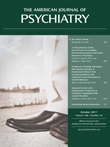A Critical Review of the First 10 Years of Candidate Gene-by-Environment Interaction Research in Psychiatry
Abstract
Objective:
Gene-by-environment interaction (G×E) studies in psychiatry have typically been conducted using a candidate G×E (cG×E) approach, analogous to the candidate gene association approach used to test genetic main effects. Such cG×E research has received widespread attention and acclaim, yet cG×E findings remain controversial. The authors examined whether the many positive cG×E findings reported in the psychiatric literature were robust or if, in aggregate, cG×E findings were consistent with the existence of publication bias, low statistical power, and a high false discovery rate.
Method:
The authors conducted analyses on data extracted from all published studies (103 studies) from the first decade (2000–2009) of cG×E research in psychiatry.
Results:
Ninety-six percent of novel cG×E studies were significant compared with 27% of replication attempts. These findings are consistent with the existence of publication bias among novel cG×E studies, making cG×E hypotheses appear more robust than they actually are. There also appears to be publication bias among replication attempts because positive replication attempts had smaller average sample sizes than negative ones. Power calculations using observed sample sizes suggest that cG×E studies are underpowered. Low power along with the likely low prior probability of a given cG×E hypothesis being true suggests that most or even all positive cG×E findings represent type I errors.
Conclusions:
In this new era of big data and small effects, a recalibration of views about groundbreaking findings is necessary. Well-powered direct replications deserve more attention than novel cG×E findings and indirect replications.



